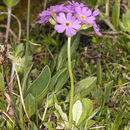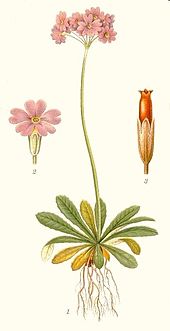en
names in breadcrumbs



Primula farinosa, the bird's-eye primrose, is a small perennial plant in the family Primulaceae, native to Northern Europe and northern Asia, and (rarely) farther south at high altitudes in the mountains of southern Europe. This primrose thrives on grazed meadows rich in lime and moisture.
This small, Arctic–alpine primrose grows from 3–20 centimetres (1.2–7.9 in) in height. The leaves are set in rosettes and are 2–10 centimetres (0.8–4 in) long and 1–2 centimetres (0.4–0.8 in) broad, smooth on top, powdery-white on the underside. The violet-blue flowers appear in early spring, and often in rounded clusters on top of a powdery stem when the plant is older.
 Early 20th century illustration of bird's-eye primrose by botanist Carl Axel Magnus Lindman.
Early 20th century illustration of bird's-eye primrose by botanist Carl Axel Magnus Lindman. Primula farinosa, the bird's-eye primrose, is a small perennial plant in the family Primulaceae, native to Northern Europe and northern Asia, and (rarely) farther south at high altitudes in the mountains of southern Europe. This primrose thrives on grazed meadows rich in lime and moisture.